Enhanced Fatigue Crack Detection in Complex Structure with Large Cutout Using Nonlinear Lamb Wave
Abstract
1. Introduction
2. Methodology
2.1. CAN of Lamb Waves
2.2. Fatigue Crack Detection Based on Nonlinear Lamb Waves
2.2.1. Phase Inversion Technique
2.2.2. Time–Frequency Feature Extraction Using CWT
2.2.3. Integrated Data-Processing Method
3. Specimen Description and Numerical Study
3.1. Specimen Description
3.2. Mode Selection of Primary Wave
3.3. Numerical Study
4. Experimental Study
4.1. Experimental Setup for Fatigue Crack Monitoring Tests
4.2. Results and Discussion
4.2.1. Fatigue Crack Propagation
4.2.2. Comparison Study: The Amplitude of Fundamental and Second Harmonic
4.2.3. Fatigue Crack Detection Using the Proposed Data Processing Method
5. Conclusions
- (1)
- During fatigue crack propagation, the crack remains closed when the specimen is unloaded. shows no significant variation due to the high acoustic transparency of closed cracks, while exhibits a distinct trend of the initial oscillating increase, and then subsequently decreases with crack growth. The result confirms that the nonlinear component (second harmonic, here) is more effective than the linear component (fundamental wave) for monitoring closed cracks.
- (2)
- The proposed integrated data processing method effectively extracts second harmonic components in sensing signal, identifies the envelope peak A2 of the second harmonic generated at the fatigue crack, and then calculates the nonlinear parameter βCAN. The parameter first increases monotonically with crack growth and then decreases after the crack reaches 8.3 mm due to the crack becoming too large to exhibit a fully ‘breathing’ behavior. Experimental results validate the efficacy of the proposed method in detecting fatigue crack growth in complex structures.
Author Contributions
Funding
Institutional Review Board Statement
Informed Consent Statement
Data Availability Statement
Conflicts of Interest
References
- Sukeerth, D.; Gowda, T. Damage tolerance evaluation for wing structure with large cutout. Int. J. Mod. Eng. Res. 2014, 4, 48–57. [Google Scholar]
- Chen, J.; Wu, W.Y.; Ren, Y.Q.; Yuan, S.F. Fatigue crack evaluation with the guided wave–convolutional neural network ensemble and differential wavelet spectrogram. Sensors 2021, 22, 307. [Google Scholar] [CrossRef] [PubMed]
- Yuan, S.F.; Jing, H.T.; Zhang, W.J. A whole service time SHM damage quantification model hierarchical evolution mechanism. Mech. Syst. Signal Process. 2024, 209, 111064. [Google Scholar] [CrossRef]
- Sampath, S.; Sohn, H. Detection and localization of fatigue crack using nonlinear ultrasonic three-wave mixing technique. Int. J. Fatigue 2021, 155, 106582. [Google Scholar] [CrossRef]
- Matsushita, M.; Mori, N.; Biwa, S. Transmission of Lamb waves across a partially closed crack: Numerical analysis and experiment. Ultrasonics 2019, 92, 57–67. [Google Scholar] [CrossRef]
- Koh, Y.L.; Chiu, W.K.; Rajic, N. Effects of local stiffness changes and delamination on Lamb wave transmission using surface-mounted piezoelectric transducers. Compos. Struct. 2002, 57, 437–443. [Google Scholar] [CrossRef]
- Ding, X.Y.; Xu, C.B.; Deng, M.X.; Zhao, Y.X.; Hu, N. Experimental investigation of the surface corrosion damage in plates based on nonlinear Lamb wave methods. Ndt E Int. 2021, 121, 102466. [Google Scholar] [CrossRef]
- Hong, M.; Su, Z.Q.; Lu, Y.; Sohn, H.; Qing, X.L. Locating fatigue damage using temporal signal features of nonlinear Lamb waves. Mech. Syst. Signal Process. 2015, 60, 182–197. [Google Scholar] [CrossRef]
- Sun, X.Q.; Shui, G.S. Investigation of the Zero-Frequency Component of Nonlinear Lamb Waves in a Symmetrical Undulated Plate. Sensors 2024, 24, 4878. [Google Scholar] [CrossRef]
- Yang, Y.; Ng, C.T.; Kotousov, A. Influence of crack opening and incident wave angle on second harmonic generation of Lamb waves. Smart Mater. Struct. 2018, 27, 055013. [Google Scholar] [CrossRef]
- Cantrell, J.H.; Yost, W.T. Acoustic nonlinearity and cumulative plastic shear strain in cyclically loaded metals. J. Appl. Phys. 2013, 113, 153506. [Google Scholar] [CrossRef]
- Solodov, I.Y.; Krohn, N.; Busse, G. CAN: An example of nonclassical acoustic nonlinearity in solids. Ultrasonics 2002, 40, 621–625. [Google Scholar] [CrossRef] [PubMed]
- Aslam, M.; Park, J.; Lee, J. Microcrack inspection in a functionally graded plate structure using nonlinear guided waves. Structures 2023, 49, 666–677. [Google Scholar] [CrossRef]
- Deng, M.X. Analysis of second-harmonic generation of Lamb modes using a modal analysis approach. J. Appl. Phys. 2003, 94, 4152–4159. [Google Scholar] [CrossRef]
- De Lima, W.J.N.; Hamilton, M.F. Finite-amplitude waves in isotropic elastic plates. J. Sound Vib. 2003, 265, 819–839. [Google Scholar] [CrossRef]
- Zhao, G.Z.; Jiang, M.Q.; Li, W.; Luo, Y.X.; Sui, Q.M.; Jia, L. Early fatigue damage evaluation based on nonlinear Lamb wave third-harmonic phase velocity matching. Int. J. Fatigue 2023, 167, 107288. [Google Scholar] [CrossRef]
- Ding, T.T.; Zhu, W.J.; Ma, C.Y.; Xiang, Y.X.; Deng, M.X.; Xuan, F.Z. Influence of cyclic-loading induced fatigue micro-crack growth on generation of nonlinear ultrasonic Lamb waves. J. Nondestruct. Eval. 2021, 40, 62. [Google Scholar] [CrossRef]
- Wan, X.; Tse, P.W.; Xu, G.H.; Tao, T.F.; Zhang, Q. Analytical and numerical studies of approximate phase velocity matching based nonlinear S0 mode Lamb waves for the detection of evenly distributed microstructural changes. Smart Mater. Struct. 2016, 25, 045023. [Google Scholar] [CrossRef]
- Cao, W.X.; Wang, K.; Zhou, P.Y.; Yang, X.B.; Xu, L.; Liu, M.L.; Fromme, P.; Pang, B.J.; Chi, R.Q.; Su, Z.Q. Nonlinear ultrasonic evaluation of disorderedly clustered pitting damage using an in situ sensor network. Struct. Health Monit. 2020, 19, 1989–2006. [Google Scholar] [CrossRef]
- Wang, K.; Liu, M.L.; Su, Z.Q.; Yuan, S.F.; Fan, Z. Analytical insight into “breathing” crack-induced acoustic nonlinearity with an application to quantitative evaluation of contact cracks. Ultrasonic 2018, 88, 157–167. [Google Scholar] [CrossRef]
- Wang, K.; Li, Y.Y.; Su, Z.Q.; Guan, R.Q.; Lu, Y.; Yuan, S.F. Nonlinear aspects of “breathing” crack-disturbed plate waves: 3-D analytical modeling with experimental validation. Int. J. Mech. Sci. 2019, 159, 140–150. [Google Scholar] [CrossRef]
- Xu, L.; Su, Y.Y.; Wang, K.; Yang, X.Y.; Yuan, S.F.; Su, Z.Q. An elastodynamic reciprocity theorem-based closed-form solution to second harmonic generation of lamb waves by a fatigue crack: Theory & experimental validation. J. Sound Vib. 2021, 509, 116226. [Google Scholar]
- Shen, Y.F.; Giurgiutiu, V. Predictive modeling of nonlinear wave propagation for structural health monitoring with piezoelectric wafer active sensors. J. Intell. Mater. Syst. Struct. 2014, 25, 506–520. [Google Scholar] [CrossRef]
- Yang, Y.; Ng, C.T.; Kotousov, A.; Sohn, H.; Lim, H.J. Second harmonic generation at fatigue cracks by low-frequency Lamb waves: Experimental and numerical studies. Mech. Syst. Signal Process. 2018, 99, 760–773. [Google Scholar] [CrossRef]
- Lee, Y.F.; Lu, Y. Identification of fatigue crack under vibration by nonlinear guided waves. Mech. Syst. Signal Process. 2022, 163, 108138. [Google Scholar] [CrossRef]
- Xu, L.; Wang, K.; Yang, X.B.; Su, Y.Y.; Yang, J.Y.; Liao, Y.Z.; Zhou, P.Y.; Su, Z.Q. Model-driven fatigue crack characterization and growth prediction: A two-step, 3-D fatigue damage modeling framework for structural health monitoring. Int. J. Mech. Sci. 2021, 195, 106226. [Google Scholar] [CrossRef]
- Xu, C.B.; Wang, J.S. Closed-crack characterization using sparse decomposition based on nonlinear Lamb waves: A numerical study. Meas. Sci. Technol. 2021, 32, 104004. [Google Scholar] [CrossRef]
- Wang, J.Z.; Shen, Y.F.; Rao, D.Y.; Xu, W. Physical-virtual time reversing of nonlinear Lamb waves for fatigue crack detection and quantification. Mech. Syst. Signal Process. 2021, 160, 107921. [Google Scholar] [CrossRef]
- Zhou, C.; Hong, M.; Su, Z.Q.; Wang, Q.; Cheng, L. Evaluation of fatigue cracks using nonlinearities of acousto-ultrasonic waves acquired by an active sensor network. Smart Mater. Struct. 2012, 22, 015018. [Google Scholar] [CrossRef]
- Guan, R.; Lu, Y.; Zou, F.X.; Wang, K.; Su, Z.Q. A simplified analytical model for the investigation of contact acoustic nonlinearity in pipe structures. Int. J. Mech. Sci. 2021, 197, 106328. [Google Scholar] [CrossRef]
- Lim, H.J.; Sohn, H. Necessary conditions for nonlinear ultrasonic modulation generation given a localized fatigue crack in a plate-like structure. Materials 2017, 10, 248. [Google Scholar] [CrossRef] [PubMed]
- Yin, S.X.; Xiao, H.P.; Xu, C.B.; Wang, J.S.; Deng, M.X.; Kundu, T. Microcrack localization using nonlinear Lamb waves and cross-shaped sensor clusters. Ultrasonics 2022, 124, 106770. [Google Scholar] [CrossRef] [PubMed]
- Sun, D.; Zhu, W.J.; Qiu, X.L.; Liu, L.H.; Xiang, Y.X.; Xuan, F.Z. Nonlinear ultrasonic detection of closed cracks in metal plates with phase-velocity mismatching. Ndt E Int. 2023, 135, 102788. [Google Scholar] [CrossRef]
- Hong, M.; Su, Z.Q.; Wang, Q.; Cheng, L.; Qing, X.L. Modeling nonlinearities of ultrasonic waves for fatigue damage characterization: Theory, simulation, and experimental validation. Ultrasonics 2014, 54, 770–778. [Google Scholar] [CrossRef]
- Lee, Y.F.; Ye, L.; Guan, R.Q. Nonlinear guided waves for fatigue crack evaluation in steel joints with digital image correlation validation. Smart Mater. Struct. 2020, 29, 035031. [Google Scholar] [CrossRef]
- Wang, R.; Wu, Q.; Yu, F.M.; Okabe, Y.J.; Xiong, K. Nonlinear ultrasonic detection for evaluating fatigue crack in metal plate. Struct. Health Monit. 2019, 18, 869–881. [Google Scholar] [CrossRef]
- Masurkar, F.; Tse, P.W.; Yelve, N. Investigating the critical aspects of evaluating the material nonlinearity in metal plates using Lamb waves: Theoretical and numerical approach. Appl. Acoust. 2018, 140, 301–314. [Google Scholar] [CrossRef]
- Zhao, Y.X.; Qiu, Y.J.; Jacobs, L.J.; Qu, J.M. A micromechanics model for the acoustic nonlinearity parameter in solids with distributed microcracks. In Proceedings of the 42nd Review of Progress in Quantitative Nondestructive Evaluation Conference, Minneapolis, MN, USA, 26–31 July 2016; Volume 1706, p. 060001. [Google Scholar]
- Jang, J.H.; Sohn, H.; Lim, H.J. Spectral noise and data reduction using a long short-term memory network for nonlinear ultrasonic modulation-based fatigue crack detection. Ultrasonics 2023, 129, 106909. [Google Scholar] [CrossRef]
- Kim, J.Y.; Jacobs, L.J.; Qu, J.M.; Littles, J.W. Experimental characterization of fatigue damage in a nickel-base superalloy using nonlinear ultrasonic waves. J. Acoust. Soc. Am. 2006, 120, 1266–1273. [Google Scholar] [CrossRef]
- Shan, S.H.; Cheng, L.; Li, P. Adhesive nonlinearity in Lamb-wave-based structural health monitoring systems. Smart Mater. Struct. 2016, 26, 025019. [Google Scholar] [CrossRef]
- Guan, R.Q.; Lu, Y.; Wang, K.; Su, Z.Q. Fatigue crack detection in pipes with multiple mode nonlinear guided waves. Struct. Health Monit. 2019, 18, 180–192. [Google Scholar] [CrossRef]
- Li, W.B.; Jiang, C.; Qing, X.L.; Liu, L.B.; Deng, M.X. Assessment of low-velocity impact damage in composites by the measure of second-harmonic guided waves with the phase-reversal approach. Sci. Prog. 2020, 103, 0036850419881079. [Google Scholar] [CrossRef] [PubMed]
- Conraria, A.L.; Soares, M.J. The continuous wavelet transform: Moving beyond uni- and bivariate analysis. J. Econ. Surv. 2014, 28, 344–375. [Google Scholar] [CrossRef]
- Cohen, M.X. A better way to define and describe Morlet wavelets for time-frequency analysis. NeuroImage 2019, 199, 81–86. [Google Scholar] [CrossRef] [PubMed]
- Sinha, S.; Routh, P.S.; Anno, P.D.; Castagna, J.P. Spectral decomposition of seismic data with continuous wavelet transform. Geophysics 2008, 70, 19–25. [Google Scholar] [CrossRef]
- Mitra, M.; Gopalakrishnan, S. Guided wave based structural health monitoring: A review. Smart Mater. Struct. 2016, 25, 053001. [Google Scholar] [CrossRef]
- Moser, F.; Jacobs, L.J.; Qu, J.M. Modeling elastic wave propagation in waveguides with the finite element method. Ndt E Int. 1999, 32, 225–234. [Google Scholar] [CrossRef]
- Kim, Y.; Lim, H.J.; Sohn, H. Nonlinear ultrasonic modulation based failure warning for aluminum plates subject to fatigue loading. Int. J. Fatigue 2018, 114, 130–137. [Google Scholar] [CrossRef]
- Chen, H.X.; Zhang, G.Y.; Fan, D.L.; Fang, L.; Huang, L. Nonlinear Lamb wave analysis for microdefect identification in mechanical structural health assessment. Measurement 2020, 164, 108026. [Google Scholar] [CrossRef]

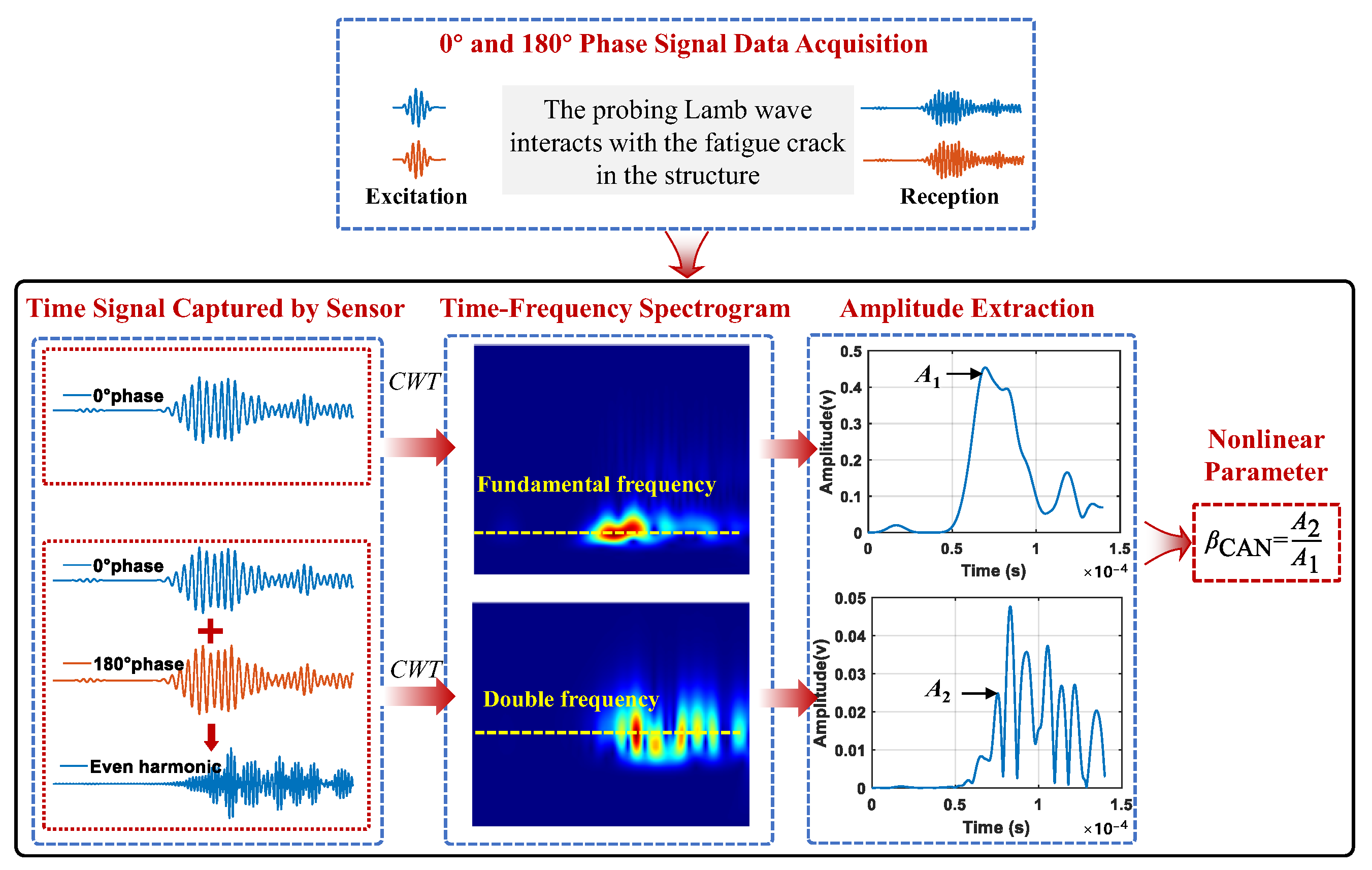

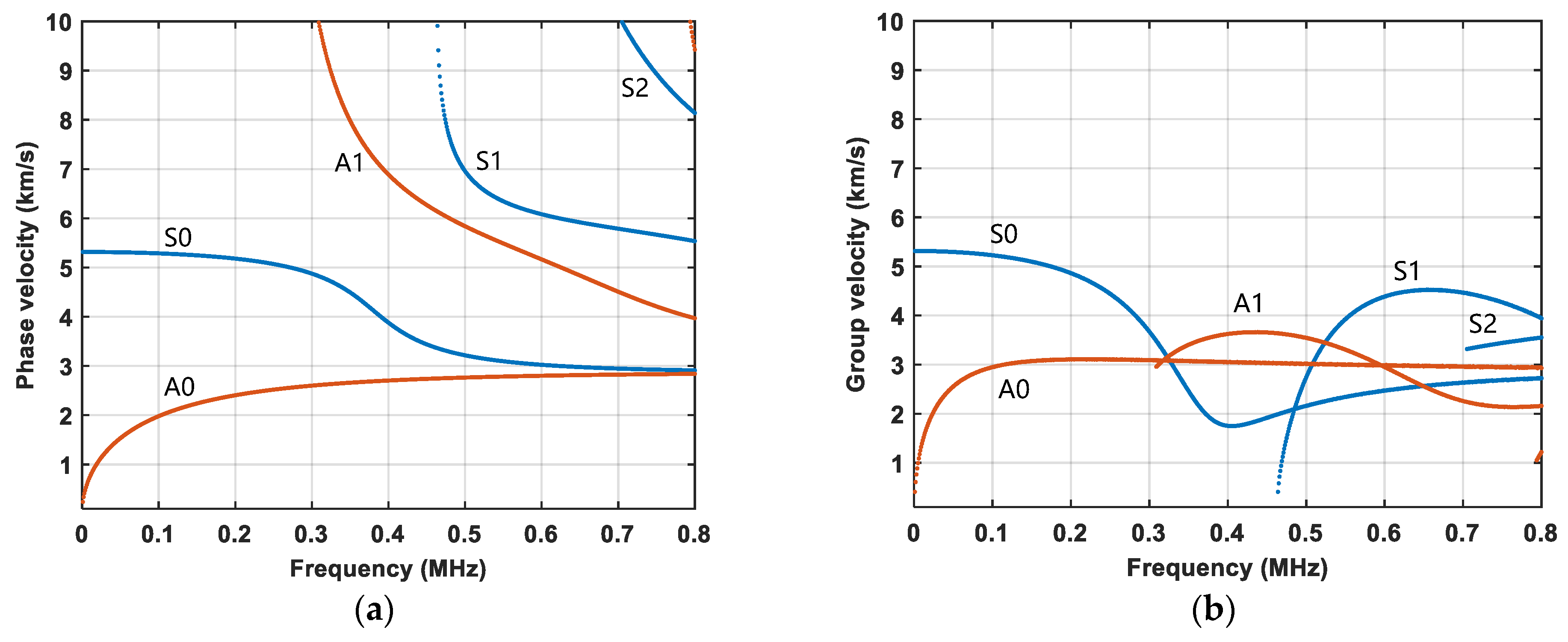





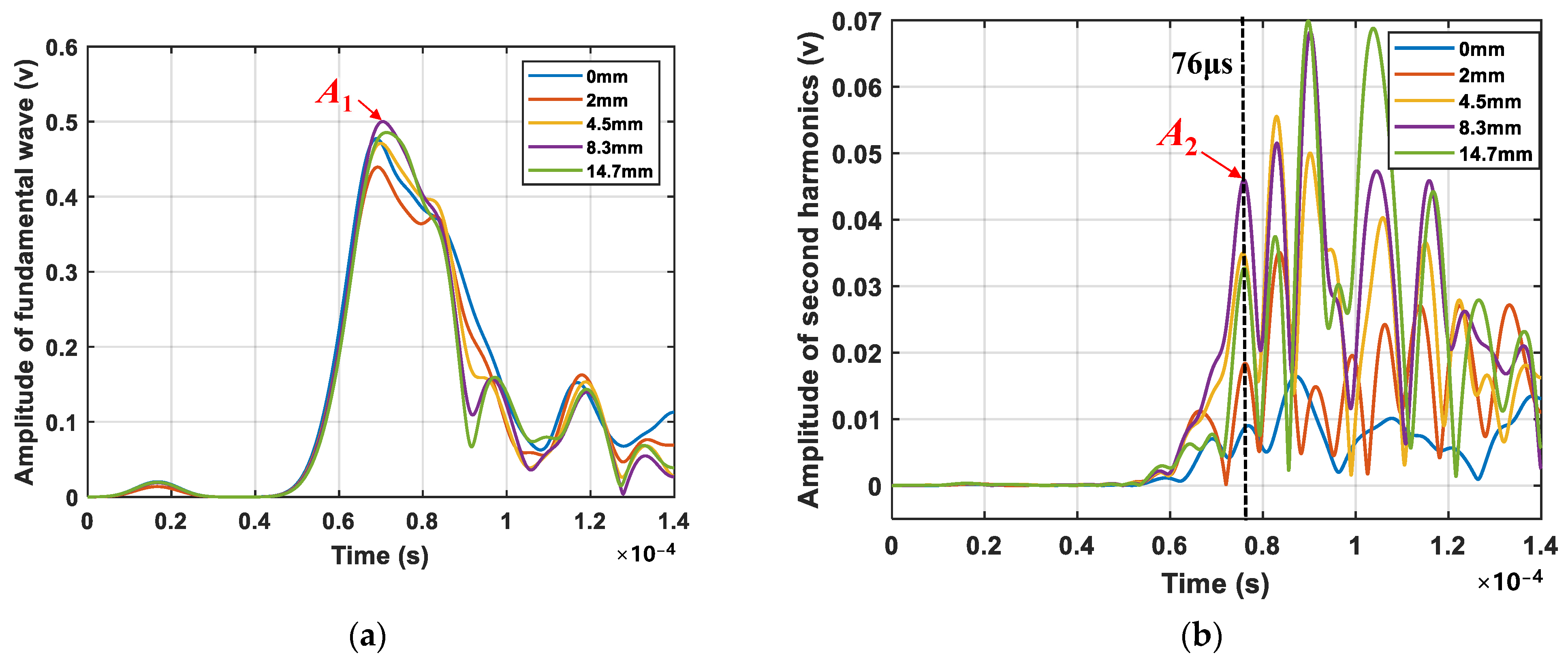
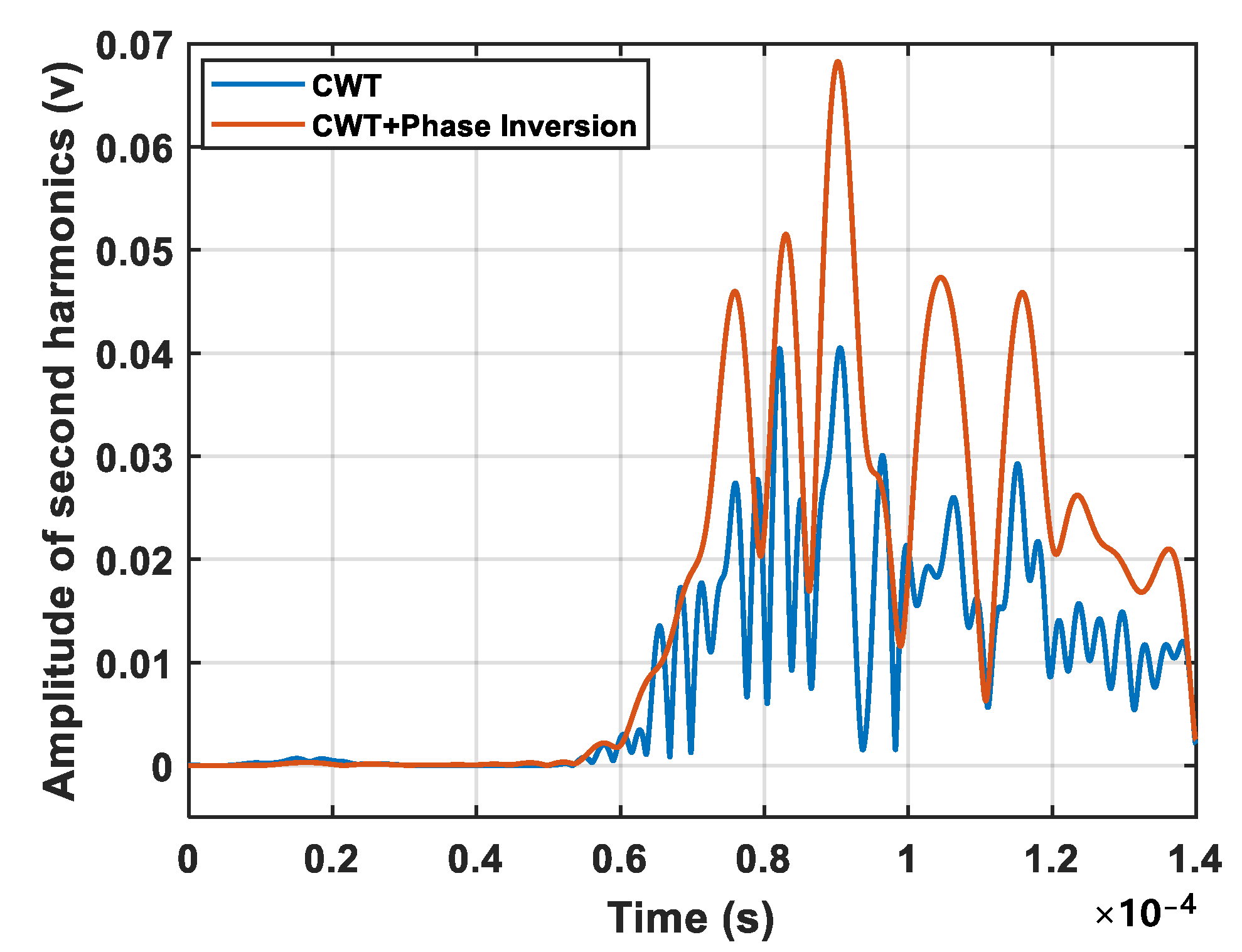
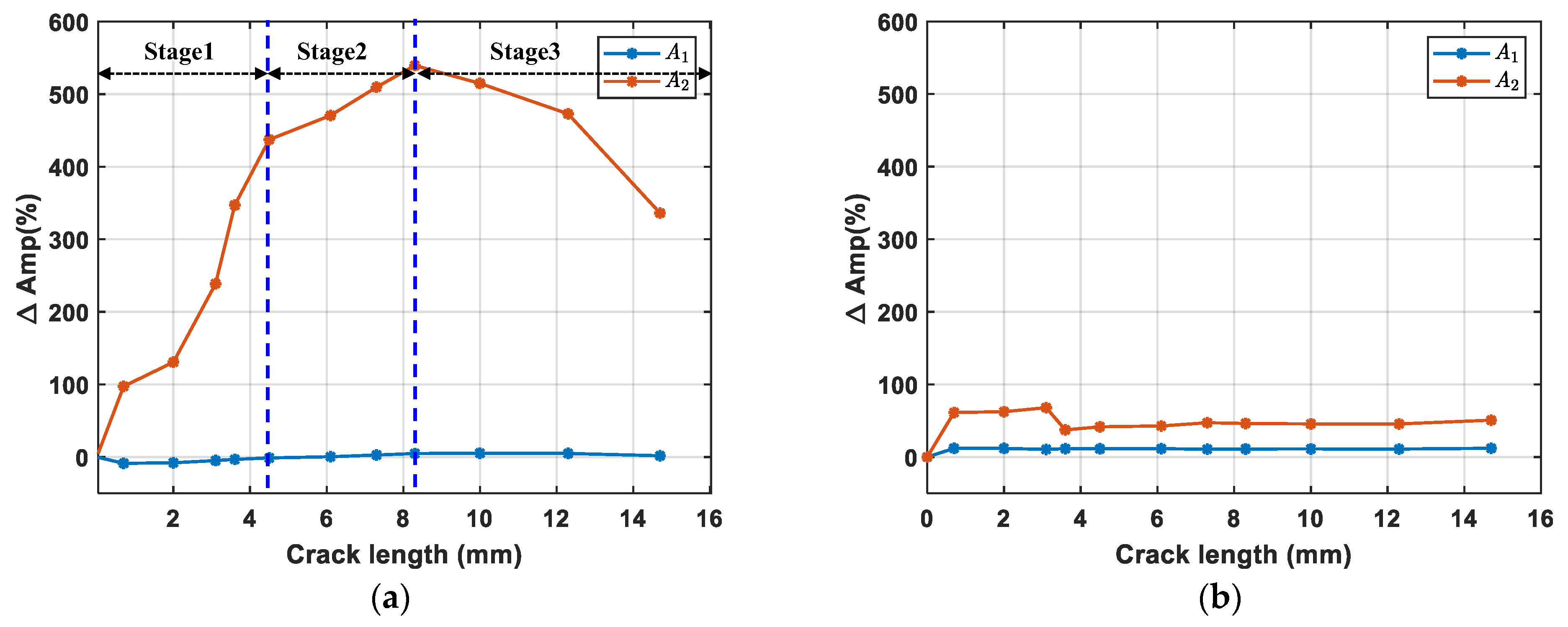

| Density (kg/m3) | Elastic Modulus (Gpa) | Poisson’s Ratio |
|---|---|---|
| 2.78 | 70 | 0.33 |
| Mode Pair | (m/s) | (m/s) | D | Lmax (mm) |
|---|---|---|---|---|
| S0-A0 | 4875 | 2801 | 42.54% | 5.49 |
| S0-S0 | 4875 | 3024 | 37.97% | 6.64 |
| S0-A1 | 4875 | 5165 | 5.90% | 72.35 |
| S0-S1 | 4875 | 6082 | 24.7% | 20.47 |
| Mode Pair | (m/s) | (m/s) | tCAN (μs) |
|---|---|---|---|
| S0–A0 | 3672 | 2981 | 77.56 |
| S0–S0 | 3672 | 2472 | 84.47 |
| S0–A1 | 3672 | 2952 | 77.89 |
| S0–S1 | 3672 | 4385 | 66.81 |
Disclaimer/Publisher’s Note: The statements, opinions and data contained in all publications are solely those of the individual author(s) and contributor(s) and not of MDPI and/or the editor(s). MDPI and/or the editor(s) disclaim responsibility for any injury to people or property resulting from any ideas, methods, instructions or products referred to in the content. |
© 2024 by the authors. Licensee MDPI, Basel, Switzerland. This article is an open access article distributed under the terms and conditions of the Creative Commons Attribution (CC BY) license (https://creativecommons.org/licenses/by/4.0/).
Share and Cite
Zhang, S.; Liu, Y.; Yuan, S. Enhanced Fatigue Crack Detection in Complex Structure with Large Cutout Using Nonlinear Lamb Wave. Sensors 2024, 24, 6872. https://doi.org/10.3390/s24216872
Zhang S, Liu Y, Yuan S. Enhanced Fatigue Crack Detection in Complex Structure with Large Cutout Using Nonlinear Lamb Wave. Sensors. 2024; 24(21):6872. https://doi.org/10.3390/s24216872
Chicago/Turabian StyleZhang, Suofeng, Yuan Liu, and Shenfang Yuan. 2024. "Enhanced Fatigue Crack Detection in Complex Structure with Large Cutout Using Nonlinear Lamb Wave" Sensors 24, no. 21: 6872. https://doi.org/10.3390/s24216872
APA StyleZhang, S., Liu, Y., & Yuan, S. (2024). Enhanced Fatigue Crack Detection in Complex Structure with Large Cutout Using Nonlinear Lamb Wave. Sensors, 24(21), 6872. https://doi.org/10.3390/s24216872







